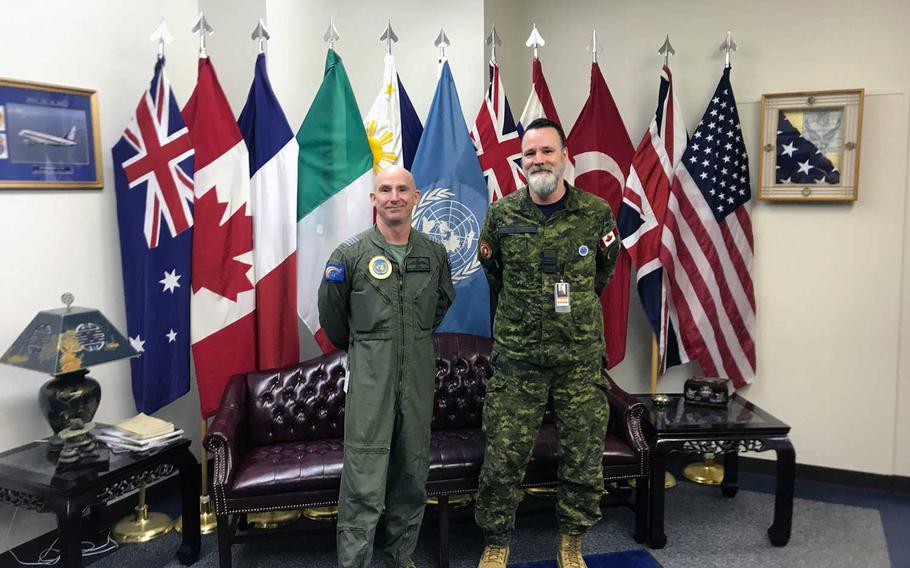
United Nations Command's Rear commander Royal Australian Air Force Col. Adam Williams, left, and deputy commander, Royal Canadian Air Force Maj. Leon Hachey at their office on Yokota Air Base, Japan, Nov. 24, 2020. (Seth Robson/Stars and Stripes)
YOKOTA AIR BASE, Japan — A pale blue United Nations banner flutters alongside the American, Japanese and POW/MIA flags over the home of U.S. Forces Japan in western Tokyo.
That banner is one of the few clues that Yokota, a key U.S. airlift hub in Japan, has also been the headquarters of the United Nations Command-Rear, since 2007.
It’s a subordinate of South Korea-based U.N. Command, led by the head of U.S. Forces Korea, Army Gen. Robert Abrams.
The command’s work in Japan is vital to the defense of South Korea since it would help facilitate reinforcements that would head to the peninsula through Japanese ports in an emergency. It also facilitates the missions of warships and aircraft that monitor North Korea’s efforts to evade U.N. sanctions.
The organization, led by Royal Australian Air Force Group Capt. Adam Williams, 48, of Brisbane, guides the movement of troops, supplies and equipment for nine of 22 nations — Australia, Canada, France, New Zealand, Philippines, Thailand, Turkey, United Kingdom and Italy — that have sent forces to South Korea as part of the U.N.’s efforts to defend the Asian democracy from communist North Korea since 1950.
“You can’t fight a major engagement in Korea without access through Japan,” Williams said during a recent interview at his office, which shares a building with the USFJ and the 5th Air Force.
The U.N. command has an agreement with the Japanese government to allow foreign forces to pass through the country to support its work in South Korea, he said. Williams is a former C-17 Globemaster III and DH-C4 Caribou pilot who has flown missions in Iraq and Afghanistan.
“It shouldn’t be normal for a French aircraft to land at a U.S. airbase and everything to work smoothly, but around here it is,” he said.
Roots in Korean conflictAt the outbreak of the Korean War, the U.N. appointed Gen. Douglas MacArthur, then supervising the post-World War II occupation of Japan, to lead the U.N.’s defense against invading North Korean communists. For the duration of the fighting and until 1957 the U.N. command overseeing the Korean campaign was headquartered in Japan.
“By 1957 it was clear that there was not going to be a rapid resolution to the political disputes, and they were going to maintain the command for some time … so the U.N. command moved to Yongsan Garrison in Seoul,” Williams said.
The command relocated last year to Camp Humphreys, south of Seoul.
The U.N. Command — Rear was established in Japan when its higher headquarters moved to Seoul. It was at Camp Zama, home of U.S. Army Japan in Kanagawa prefecture, before moving to Yokota in 2007 to be close to U.S. Forces Japan, Williams said.
The U.N. command has only five personnel working at Yokota, although that could be increased significantly in an emergency, Williams said. The staff includes a Canadian deputy commander, two American soldiers and an American civilian.
That’s far fewer than the command has at Camp Humphreys, where about 90 staff work, he said. Numerous other personnel in South Korea perform missions that range from demining to monitoring the Demilitarized Zone that separates the country from North Korea.
Royal Canadian Air Force Maj. Leon Hachey, 53, of Richards Landing, Ontario, has been at Yokota for two years as deputy commander. A change to Canadian Air Force regulations allowed him to grow a beard that has been getting thicker since 2018.
Working in a multinational environment is nothing new to Hachey, who traveled to Afghanistan in 2007 as a logistics officer.
The U.N. Command -- Rear gets some VIP visitors such as South Korean army brass and members of the South Korean National Assembly. But Hollywood stars who have taken an interest in other U.N. missions have yet to stop by, Williams said.
“Outside of a few professionals who work on these agreements that have been around for 65 years, our work is not well-known,” he said.
Sanctions monitorsThe U.N. command staff wear their national uniforms, but you won’t see blue berets or helmets, which are reserved for U.N. peacekeepers, he said.
U.S. forces are the U.N. command’s key mission partners in Japan, Williams said.
“We are clearly not out there throwing ropes to the boats and refueling aircraft,” he said of his staff.
A big part of the command’s work in Japan involves facilitating ships and aircraft passing through the country to monitor compliance with sanctions on North Korea that the U.N. imposed due to the North’s nuclear weapons program, Williams said.
“The sending states are committed to monitoring sanctions on North Korea,” he said. “A lot of the ships and aircraft that have visited Japan in recent years have been sanctions monitoring activity.”
The U.N. command’s work in Japan can also involve evacuating foreign forces from bases in the path of typhoons or arranging medical care for inured troops.
For example, a U.S. sailor recently fell down a hatch on a vessel that was near a warship involved in sanctions monitoring, Williams said.
“We had a Canadian ship in the area and brought guy from the U.S. ship to the HMCS Winnipeg, which evacuated him by helicopter to Sasebo,” he said.
Yokota is one of seven U.S. military bases in Japan where the U.N. command has access to logistical support for nations sending troops to South Korea, Williams said.
The other installations are Yokosuka and Sasebo naval bases and Camp Zama on the main islands of Japan as well as Kadena Air Base, Marine Corps Air Station Futenma and White Beach Naval Base on Okinawa.
robson.seth@stripes.com Twitter: @SethRobson1